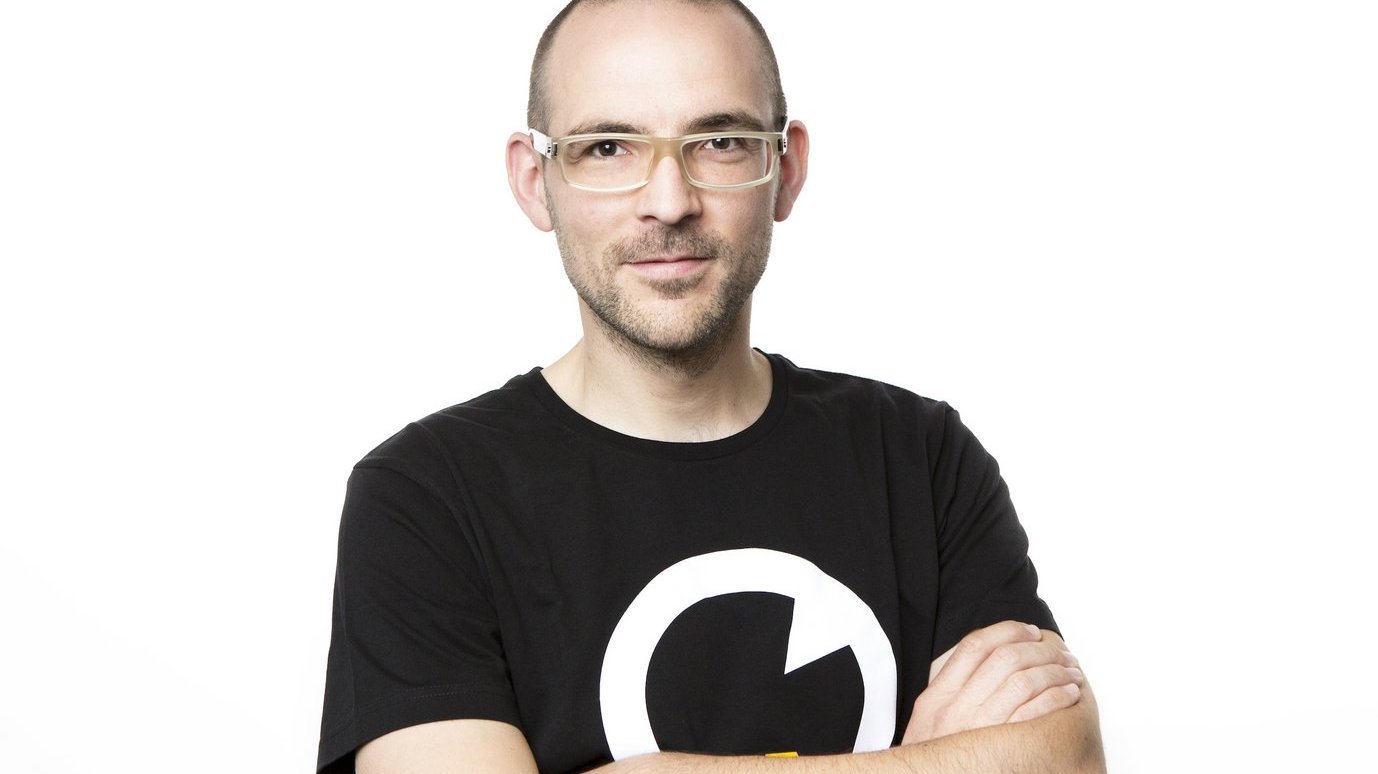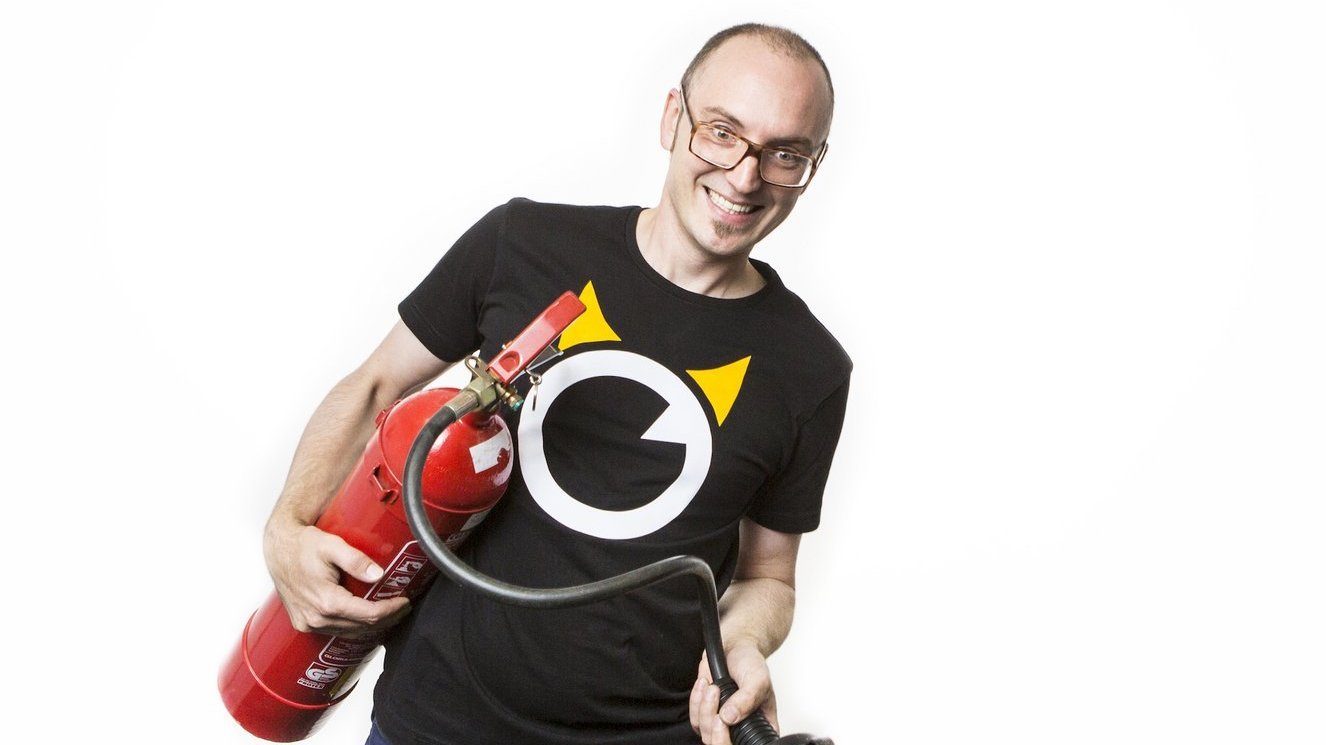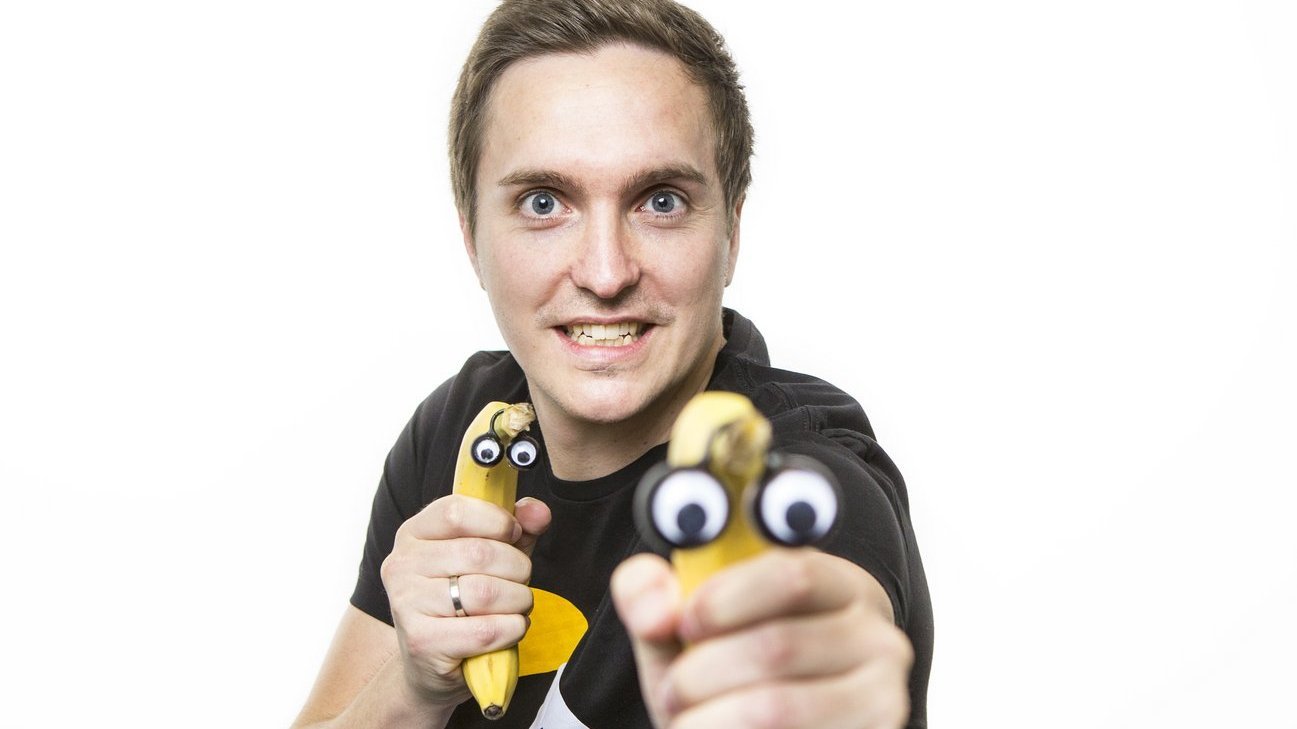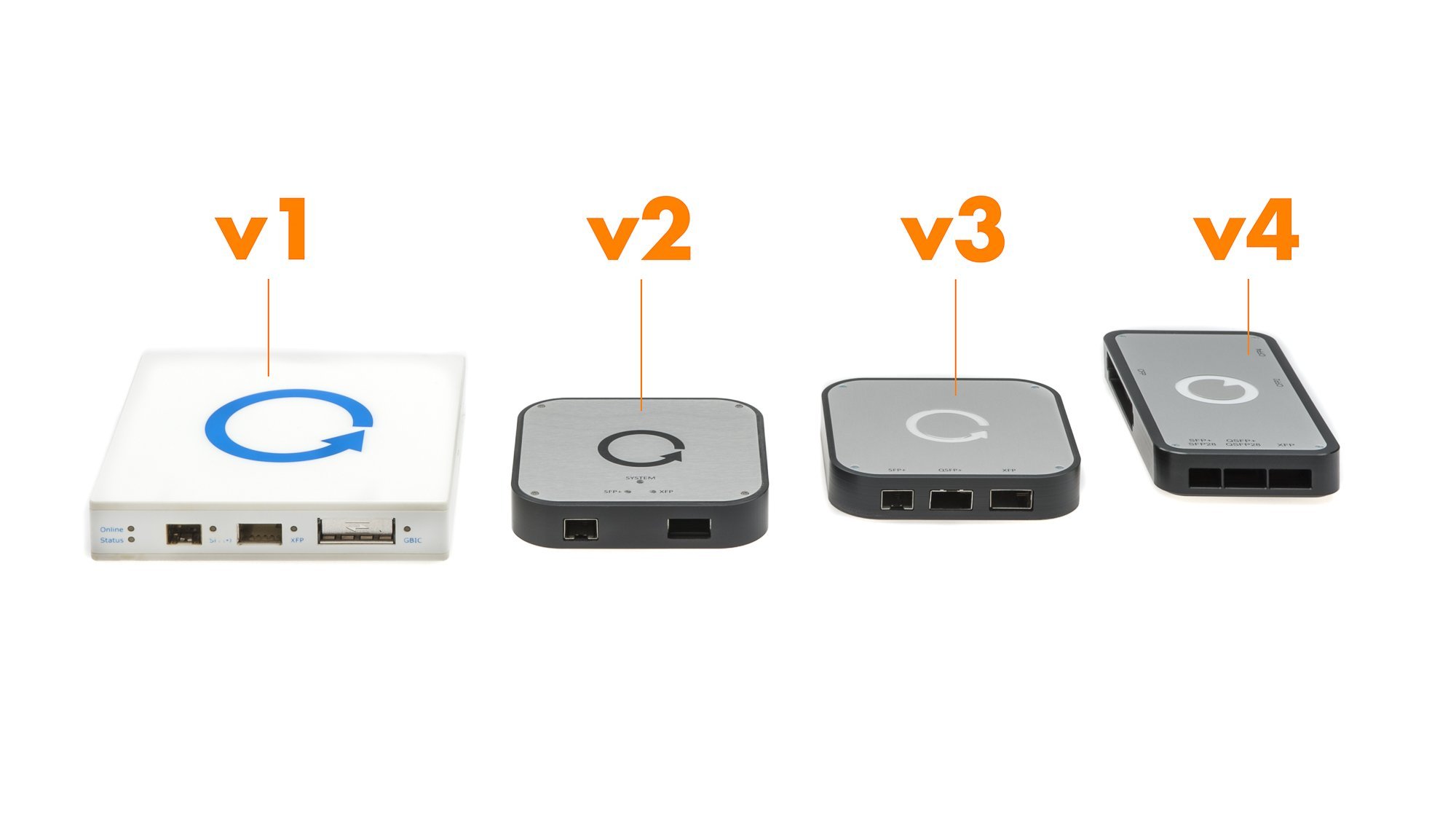“We’ve managed to safeguard our otherness”
 Stephan Werner, Thomas Weible and Markus Arnold in front of the Flexoptix headquarters
Stephan Werner, Thomas Weible and Markus Arnold in front of the Flexoptix headquarters
Deep in the countryside between Darmstadt and Mühltal is where an IT-company, founded and managed by h_da graduates, has its headquarters. Markus Arnold, Thomas Weible (both 40) and Stephan Werner (36) had a former restaurant converted into the company head office of ‘Flexoptix’. They’re currently gradually expanding the premises to form a technology campus, aimed at combining living and working facilities. We conducted the interview, Covid-compliant, wearing their firm’s luminous orange face-masks. Their motto mirrored by the printed slogan: ‘Less bullshit, more engineering’.
Mr Arnold, Mr Weible, Mr Werner, rapid internet is in extremely high demand, whilst technological development is hurtling away. Positive market conditions for you then?
Markus Arnold (MA): Yes, bandwidths are expanding at a gigantic pace. All the videos and streams that we access on a daily basis have to be shovelled through the net, after all. All of which pushes copper wiring as a transfer medium to its limits. There’s no way around using fibre-optic cables for high bit-rate connections over long distances.
Thomas Weible (TW): When we started up in 2008, a data rate of 1 gigabit per second was the standard. There have been three major technological leaps since then: to 10, 100 and nowadays 400 gigabit per second.
20 years ago we were begging beeping modems made by Elsa to “connect us to the internet, please!” A tremendous amount has happened since then, so could you distill into three sentences precisely what it is Flexoptix provides?
TW: Okay, the challenge is on – so we’ll take a sentence each. Here’s mine: we’re manufacturing the Elsa modem made in 2020 …
Stephan Werner (SW): … but one that transfers light, not electricity.
MA: There are lots of modems, but only one type of connection that fits all.
Not bad, that was even a mere two sentences. However, I fear you’ll still have to explain it all in slightly more detail ...
MA: I’ll just expand on this a little. In the field of network technology there are many different standards, devices and specifications, leading to interface problems. In order to reduce this diversity, manufacturers began to standardize and modularized the physical connections – for example the type of fibre-optic cables – in effect outsourcing the actual connectivity of their devices. They concentrate on universal terminals which perform the core tasks of routing and switching. So-called transceiver send and receive the data signals in fibre-optic networks.
TW: A early modem managed 14.4 kilobits per second, a 400G transceiver can cope with 425 millions. Among other things, we offer pluggable transceivers and programme the software for them.
MA: Moreover, we developed the Flexbox, including its software. It’s a universalized programming interface for the manufacturers’ optical modules, which are now available in fourth generation versions. By dint of the fact hardware standards are interpreted differently, the data transfer between network components doesn’t always readily work. Almost every existing industry standard can be connected to the Flexbox. It teaches the terminals to communicate with one-another. Moreover, it also functions as a measurement and diagnostics device. Some clients therefore refer to it as the Swiss army knife for network planners. With the Flexbox, we were among the first ones to make it possible to universalize optics. In the meantime, some market players have followed suit.
Who are your clients?
MA: Fibre-optic network operators. For instance, DE-CIX in Frankfurt, which is the largest commercial internet hub in the world, a variety of telecommunications providers, as well as campus network providers, such as the h_da. An up-to-date pluggable transceiver costs up to €20,000. When they need to make changes to a network, the providers have an appropriately strong interest that the transceivers it contains can continue to be used.
TW: We entered the market in 2009 as a platform. Nowadays, people would refer to it as Cloud-Service.
MA: We provide a central web service capable of operating all the Flexboxes across the globe. This enables our users to programme their transceiver, to suit their needs, via laptop or smartphone.
How do you all get on with your positions as CEO, CTO and COO?
TW: Stephan is our Chief Operating Officer because he’s great at organizing, along with establishing structures and appropriate processes. Having trained then worked at a bank before taking his degree, he’s got a different background to Marcus and myself. Markus is very good at maintaining an overview of complex issues, at thinking five steps ahead and pin-pointing potential vulnerabilities – which is why, as CEO, he concerns himself with our strategic orientation. As Chief Technology Officer, I’m basically the creative energy, the punk or maverick.
MA: We discuss all important issues together and reach decisions jointly. Everyone has their strengths and weaknesses …
TW: … which all three of us respect. We are complementary aspects of our overall inhomogeneity.
What drove you to study at the h_da at the time?
MA: Decisive for all of us was the computer science cooperative degree course (“KoSI”, see also info box). We liked the concepts behind the universities of cooperative education (vocational training). We didn’t only want a degree course, but rather for it all to have practical relevance and provide an income.
SW: Darmstadt was relatively large and easy to get to, which were also plus points.
The Cooperative Study course Informatics (“KoSI”) is a sandwich course variant of an informatics degree course at the h_da, and is seen as something of a trendsetter for sandwich courses in Hessen. KoSI combines themes from general and business informatics, has a standard study period of seven semesters and leads to graduation as a Bachelor of Science. KoSI students are employed by a company in the IT sector, whereby they can gather valuable experience during semester breaks and holidays and are remunerated throughout.
During their practical phases, the students work on projects relating to the company’s everyday operations, whereby they are jointly supervised by both the company and the university. Optional modules enable students to set individual focal points, subsequent specialisation is then possible within a Master’s degree course. The Bachelor’s degree course in Cooperative IT Safety (KITS) is similarly organised.
KoSI graduates Markus Arnold, Stephan Werner and Thomas Weible are involved in the alumni network for cooperative study courses in informatics, or ExKoSI (DE). The registered association is committed to maintaining contact and encouraging an exchange of knowledge between former students and with the economy. To this end it initiates, among other things, research projects, allocates grants or hosts graduation parties.
How did you get to know one-another?
MA: In 2000 I was in my second semester of the new degree course KoSI, which was still held in Dieburg at the time. Thomas started in 2001, and we were both lived in the same halls of residence in Altheimer Straße.
TW: After that our ways parted for a while. Markus started work and I took my Master’s – but we kept in touch. We founded the company in January 2008. Stephan has begun his studies in 2006, and he joined us in 2009.
SW: Markus was my KoSI supervisor from the corporate side. In 2010 I began to take my Master’s in business informatics part-time at the h_da. I became COO in 2013.
TW: During the initial phase, Helmut Wörner, the founder of Controlware GmbH in Dietzenbach, was very important to us. He encouraged us and made certain things feasible, but we still had to discover and then go our own way.
MA: Helmut Wörner rented office space out to us in his company premises, which became our first regular company headquarters. He became a mentor and sparring partner to us, both challenging and supporting us – for which we are very grateful.
Your present-day firm’s headquarters is highly unusual. What’s the history behind it?
MA: As of 2014 we were looking for new premises, and we agreed this wouldn’t be located on some sterile industrial estate.
TW: We came upon the idea of setting up a technology campus, one that combined living quarters with a workplace. We eventually stumbled across this property, with its seven buildings set on a plot roughly 10,000 square metres in size. We moved into the converted former restaurant in 2017. We’re currently renovating the historic Koppenmühle according to listed building specifications. It’ll provide living space for staff or outsiders.
MA: We love the surroundings, Nature, all the animals here. You might spot a deer, or a heron will swoop by. Plus, the location has proved its worth, for the federal highway provides ideal access to the A5 motorway and the airport, which is important for a lot of our clients.
Which other major changes have occurred since 2008?
MA: our customer base has become more international, and we suddenly had users in South America and South Africa. This is one of the reasons we needed to design and configure our web services to be available world-wide.
TW: In 2012 we settled on direct sales via a B2B shop – and for absolute transparency: our prices and warehouse stock levels are accessible, which has proven very beneficial. The shop answers such standard questions as: ‘have you got this part in stock – and when can you get it to me?’ for us.
How many staff members do you employ right now?
TW: Around 60. World-wide (grinning). We’ve got one staff member in each of the following: the USA, South Africa and Berlin, the others are all located in the Rhine-Main region. The global production of transceivers is based in Asia, ours included. Our own products are assembled in Seligenstadt by an external partner company.
MA: The relatively small number of units has proven its worth. The company headquarters is the only facility. Around 40 people work here, where we design and construct our prototypes in the cellar.
How does the Covid pandemic affect your business?
TW: Our world-wide field service representatives don’t travel quite so often, but this works well enough. They were already used to work remotely part of the time – and now we no longer have to ask for clients understanding. Covid has effectively shoved us all out of our comfort zones.
MA: Nowadays most people work independent of location, and we’ve got this trove of common experiences. Video conferences have become the norm, for example.
SW: We believe that in retrospect, some of it will be viewed as being positive.
Young professionals are often advised to be open, curious and bold. Would you agree, or which other characteristics occur to you?
MA: A young person can be a bit too cautious in some areas, yet in others, they may overestimate their capabilities. I think such insecurity or naivety is important. Naturally, experience is also important, however, these days you also need precisely those people who will simply get up and get going, trying to find out whether something works or not.
TW: I wholly indorse that. It’s important that we keep some bite and the willingness to get your hands mucky.
SW: Able to demonstrate ambition and initiative, wanting to join in, to get involved: do it! These are the skills you have to bring along with you – then it all just evolves …
Your very headquarters, your public image, it all manifests a start-up spirit, even though you’ve been in business for the past 13 years. Is this a USP?
MA: Sure, we’ve managed to safeguard our otherness. It’s always more arduous not to go with the flow. However, we believe you can nonetheless be successful. And we believe in getting down to it – otherwise, it all remains mere pipe dreams.





